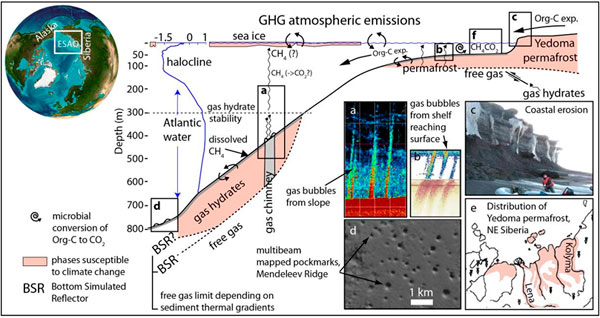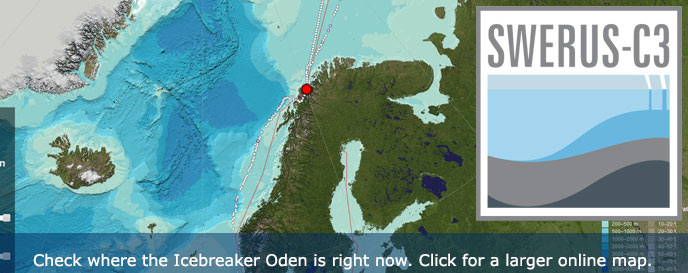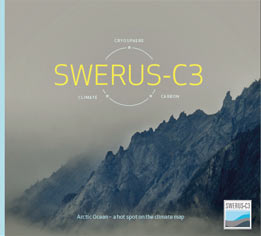Swedish – Russian – US Arctic Ocean Investigation of Climate-Cryosphere-Carbon Interactions – The SWERUS-C3 Program –
SWERUS-C3 is a multi-disciplinary program with base funding supported from by the Swedish Knut and Alice Wallenberg Foundation (KAW) aiming to investigate the linkages between Climate, Cryosphere (here: sea ice and coastal permafrost) and Carbon release from the sediment, with addition of greenhouse gases (GHG) to the atmosphere. SWERUS-C3 includes principal investigators from Stockholm University, University of Gothenburg, Pacific Oceanological Institute, P.P. Shirshov Institute of Oceanology, Russian Academy of Sciences (RAS), National Tomsk Research Polytechnic University, the International Arctic Research Center (IARC) at University of Alaska, Center for Coastal and Ocean Mapping at University of New Hampshire and Rice University.
The SWERUS-C3 Program focuses on investigations of the present and historical functioning of the multi-process C3 system of the East Siberian Arctic Ocean (ESAO). The ESAO is the target area because it is experiencing the fastest rates of climate warming and because of its vast stores of vulnerable carbon. The ESAO is sparingly explored despite hosting 80% of the World’s subsea permafrost with large amounts of C-CH4 currently stored in the shelf and slope sediments and in its coastal Yedoma permafrost. This yields a likely potential for climate-induced mobilization of these carbon pools into the atmosphere as GHG; a positive feedback to climate warming.
The objectives of the SWERUS-C3 research program are to quantitatively address processes central to Arctic Ocean Climate Change Feedbacks, specifically:
| (i) CH4 release from subsea permafrost and deep sea: What are the mechanisms and magnitudes of CH4 release to the atmosphere? What are the permafrost and gas hydrate stability fields of Arctic subsea CH4 pools and how will they respond to increased ocean warming? (ii) The fate of carbon in the shelf sea released from thawing subsea and coastal permafrost: Microbial degradation and CO2 fluxes to the atmosphere? Or re-sequestration through sediment burial and off-shelf export? (iii) The historical (recent/post-glacial/paleoclimate) sediment record of permafrost carbon releases: Is the present carbon release from thawing permafrost unprecedented since the last glacial period? (iv) History of Arctic sea ice and its impact on carbon fluxes: Has a perennial Arctic sea ice cover prevailed during the entire post-glacial period or have sea-ice free summers existed previously? |

Fig. 1. Schematics of key components of the Arctic climate-cryosphere-carbon system that are addressed by the SWE-C3 Program. a,b) Sonar images of gas plumes in the water column caused by sea floor venting of methane (a: slope west of Svalbard, Westbrook et al., 2009; b: ESAO, Shakhova et al., 2010, Science). c) Coastal erosion of organic-rich Yedoma permafrost, Muostoh Island, SE Laptev Sea. d) multibeam image showing pockmarks from gas venting off the East Siberian shelf. e) distribution of Yedoma permafrost in NE Siberia. f) Atmospheric venting of CH4, CO2.








